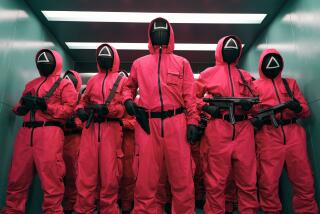Filmmaker bristles over Australia’s barring of North Korean artists
- Share via
Reporting from Seoul — Nick Bonner has a cautionary tale about propaganda, censorship and North Korea. But it’s not what you think, he says.
The British filmmaker and art dealer had helped commission five North Korean painters to produce works for an Australian art exhibit, inviting them to come and talk about their craft and inspiration.
This week brought a last-minute catch, a tableau where politics overshadowed art. But it didn’t come from one of the world’s most-repressed societies.
Instead, Australia denied entry visas for the artists, calling their work a product of North Korea’s propaganda machine.
Now Bonner is forced to display the paintings without the painters. And he accuses Australia of censorship.
“This is a government telling its art patrons what artists they can learn from. If that’s not censorship, I don’t know what is,” the Beijing-based entrepreneur said. “How could they be so naive, so paranoid, so bureaucratic?”
The Australian Foreign Ministry says the visa ban is part of its response to North Korea’s efforts to develop missiles and nuclear weapons. To make an exception in this case, it says, would have sent an inappropriate message to North Korea.
“The artists concerned are from a studio that operates under the guidance of North Korea’s leader Kim Jong Il,” a spokesman said in a statement. “The studio reportedly produces almost all of the official artworks in North Korea, including works that clearly constitute propaganda aimed at glorifying and supporting the North Korean regime.”
Australia froze relations with the communist nation in 2002. Kim’s government last year closed its embassy in Canberra, the Australian capital, citing financial reasons.
North Korea walks a delicate and seemingly contradictory cultural and political line, courting international sanctions and isolation with its weapons programs but occasionally reaching out to the world. The New York Philharmonic was invited last year to perform in North Korea, which has also joined international competitions in gymnastics and soccer.
Pyongyang watchers on the Korean peninsula were divided Thursday on Australia’s decision.
“Australia joined the U.N. sanctions against North Korea, which include regulations on people. But it seems an overly political way to handle cultural and artistic activities,” said Lee Woo-young, professor at the University of North Korean Studies in Seoul, the South Korean capital.
But Lim Soon-hee, a research fellow at the Korea Institute for National Unification in Seoul, said the artists’ visit could have been a windfall for North Korean propaganda.
“Art and cultural policies in North Korea are tools for political propaganda and idolization of [late leader] Kim Il Sung and Kim Jong Il, rather than pure, nonpolitical schemes,” he said.
Bonner, who has made several documentary films in North Korea, in 2006 commissioned the Mansudae Art Studio to produce 15 pieces dealing with industrial landscapes for showing at the Asia Pacific Triennial of Contemporary Art in South Brisbane, Australia. The display, which will be up through April, features the works of 100 artists in 25 nations.
Though he acknowledged that North Korea’s art studios are government-run, as are most organized activities in the country, he said that doesn’t mean that all the works produced there are political.
Mansudae, which houses 1,000 artists, has produced work for several exhibits in Italy, according to the studio’s website.
Bonner encouraged the artists to avoid the socialist realism style typical of most communist propaganda.
“We didn’t want works that glorified workers, but something more understandable to Australians -- their humility,” he said.
Still, for many of the artists the assignment was a stretch. Finally, a painter showed Bonner a photograph of a blue-collar worker smoking a cigarette. “He said, ‘Is this what you mean?’ and we said, ‘Yes!’ It was a real breakthrough,” Bonner said.
He said the completed works -- including sketches and portraits in oil paint and ink -- express ideas that are groundbreaking for the North Korean artists, such as a painting that shows the smoky fires of an industrial foundry.
“I’ve let them down,” Bonner said of the artists. “I promised them an opportunity to explain their work. They paint beautifully; that’s why they were invited. For them to speak to other artists and patrons from a foreign land would have been a real breakthrough.”
Bonner said the project was never intended to be political.
“But the Australian government has managed to turn it into that,” he said. “It’s bloody frightening when a government steps in to overrule an art gallery. That’s just wrong.”
Researcher Ju-min Park in The Times’ Seoul Bureau contributed to this report.
More to Read
The biggest entertainment stories
Get our big stories about Hollywood, film, television, music, arts, culture and more right in your inbox as soon as they publish.
You may occasionally receive promotional content from the Los Angeles Times.











